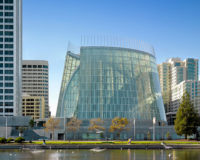Background Notes: The Parthenon and its Panathenaic Frieze
PeopleArchitect: Snow Kreilich Architects Inc. Design Architect: Snow Kreilich Architects Architect of record: Ryan A+E Sports Architect: AECOM Engineers: Mechanical Engineer: Schadegg Mechanical, Inc. Consultants Design landscape architect: Bob Close Studio General contractor: Ryan Companies Photographer: Paul Crosby & Christy Radecic Client: City of St. Paul and the St. Paul Saints Size: 347,000 square feet Cost: $63 million Completion date: May 2015
|
ProductsStructural System Structural System: http://www.cmf-inc.com provided structural steel, http://www.amerectinc.com erected the structural steel Exterior Cladding Masonry: Masonry: Custom block supplied by Amcon Block http://www.amconblock.com, http://sericeconstruction.com installed masonry Metal panels: Metal: MG McGrath Inc. Miscellaneous Metals were by http://metro-mfg.com see exterior wall systems for metal panels by http://mgmcgrath.com Precast concrete: http://www.ryancompanies.com for placement and finishing, http://www.avrconcrete.com - supplied ready-mix concrete, Wood: Ceilings (wood): MG McGrath Inc. http://mgmcgrath.com installed western red cedar with clear finish as furnished by Weekes Forest Products http://www.weekesforest.com Other cladding unique to this project: Metal: MG McGrath Inc. Miscellaneous Metals were by http://metro-mfg.com see exterior wall systems for metal panels by http://mgmcgrath.com Glazing Glass: Empirehouse, Inc. http://www.empirehouse.com; Oldcastle BuildingEnvelope (glass, storefront, curtainwall and operable windows at press/media area); Wasco (skylight); Insulgard (ticket windows) Interior Finishes Acoustical ceilings: Acoustical System: http://www.archsalesmn.com Armstrong for ACT ceilings, Sonex for the acoustic foam material in the Saint’s office on the Service Level, MG McGrath Inc. http://mgmcgrath.com installed custom acoustic wood ceiling in Securian Club Room Cabinetwork and custom woodwork: Millwork: Artifex Millwork Inc. http://www.artifexmillwork.com Paints and stains: Paints and Finishes: http://www.rainbowincmn.com majority of the paint is Sherwin Williams through-out (interior/exterior) Lighting Dimming system or other lighting controls: Lighting Control Systems: http://www.huntelec.com installed lighting systems including local controls (wall switches and light sensors). Some of the lighting control was also provided by Humeratech through the building management system. Energy Photovoltaic system:Photovoltaics or other Renewables: http://www.huntelec.com Hunt installed the entire solar array (PV systems), structure is by Presidential Steel Buildings, PV panels are by Sun Power |



